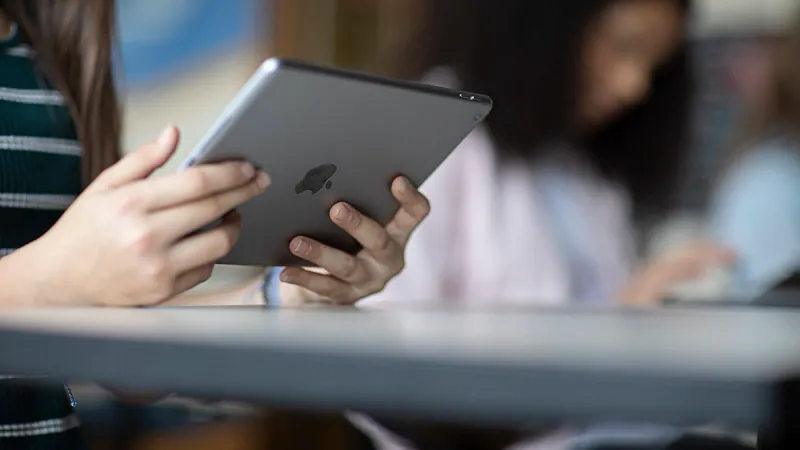Is technology meant to solve the most important challenges in education?
We would argue that it is not, and measuring the use of digital tech in schools through that lens will always make tech come up short. Digital tech can be a wonderful tool for solving important challenges and even transforming education based on educational models such as TEAL+ or Active Learning.
Has it transformed education? In some places, and with some models, it absolutely has. In others, it has helped them to implement their already-existing pedagogy and curricula in a more streamlined, user-friendly manner.
Let's take their points and tackle each one, shall we?
Statement: evidence for tech improving education is thin.
"There is little robust evidence on digital technology’s added value in education," says the report. "Technology evolves faster than it is possible to evaluate it: Education technology products change every 36 months, on average."
Response: technology reviews can often focus on the wrong things.
In many cases, when an organization reviews technology's impact on any field, it focuses on the technology and misses the people using the technology.
It is never easy to isolate the single cause of any intervention in a school; it can be an attitude change as much as the new tool or approach, and this is why technology impact surveys vary so much.
One thing that is clear is that educators' knowledge, skills and confidence are key to any transformation. Technology can support outcomes in a number of factors, but will never be solely responsible for them.
In order for educational tools to support learning, those reviewing and using the tech should know:
- How a specific technology can inspire educators and learners
- How it can be used to reduce teacher and administrator workload
- The potential of the tech for developing new assessment opportunities that enable student success
Statement: educational technology benefits only some.
"Technology offers an education lifeline for millions but excludes many more," says UNESCO.
The report acknowledges that radio, television and mobile phones help to educate hard-to-reach populations. However, while also giving credit to distance learning that "stopped education from melting down during COVID-19 school closures," it said that 31% of students worldwide and 72% of the poorest did not benefit from this technology.
The report also discussed how "The right to education is increasingly synonymous with the right to meaningful connectivity, yet access is unequal." UNESCO pointed to the fact that globally, only 40% of primary, 50% of lower secondary and 65% of upper secondary schools are connected to the internet.
UNESCO also acknowledged: "accessible technology and universal design have opened up opportunities for disabled learners."
Response: accessible technology and universal design have opened up opportunities for everyone.
As is nearly always the case, meeting the needs of disabled students can open up access to everyone, especially in those schools focusing on Universal Design for Learning (UDL).
UDL is a change in approach that uses technology—technology cannot do more than support and enable this model of learning. UDL is bigger than a focus on needs. It can help educators see that designing for outcome over process supports many learners from all kinds of backgrounds and abilities to express understanding and knowledge of the material as well as foster cognitive thinking skills.
Want a more in-depth understanding of UDL? Learn how Jamf helps schools commit to UDL from our ebook: "Bringing Universal Design for Learning (UDL) To an Innovative Classroom With Technology." >>
(Even if this tech and universal design approach really did open up opportunities exclusively for students with disabilities, disabled people make up 20% or more of the global population. That's a lot of people.)
Statement: trying to keep up with tech strains school systems.
"The fast pace of change in technology is putting strain on education systems to adapt," says the UNESCO report. While "countries are starting to define the digital skills they want to prioritize in curricula and assessment standards, often these have been defined by non-state, mostly commercial, actors."
Response: it's possible to use technology to lift strain from school systems.
Schools that use technology successfully understand that technology is a supporting tool: nothing more, nothing less.
For instance, a school district that uses an MDM such as Jamf School to manage and secure their entire fleet of Apple devices in multiple schools has streamlined and automated their IT, which means they need fewer IT personnel working fewer hours or spending their time working on educational innovations.
In most cases, the technology itself becomes just another tool —a digital pencil case— that supports flexible teaching styles, assessments, assignment planning and more. This can free up people who ordinarily struggle with classroom management or learner engagement to take a breath and think about what will best serve their district, schools and classrooms.
Often, students determine the way tech can support their educations and futures. Once they understand those initial foundational skills, this can develop into a key skill needed for future employment.
And when school districts and teachers learn that there are many ways to solve to a given problem, they can begin to move away from the one-size-fits-all approach of a more traditional classroom. They can truly engage students as they learn creative problem-solving and critical-thinking skills.
Statement: technology purchases can be shortsighted.
"Technology is often brought to plug a gap," says the report, "with no view to the long-term costs."
These costs are to:
- National budgets: tech and internet connection subsidies
- The environment: CO2 emissions from laptop manufacturing
- Children’s well-being: online dangers and in-school surveillance
In fact, the report explained, the C02 emissions that could be saved by extending the lifespan of all laptops in the European Union by a year would be equivalent to taking almost one million cars off the road.
Response: it is possible to lower costs and raise protections.
Budgets
Investing in tech with a low TCO, longer lifespan and responsible security systems that protect student privacy can make an enormous difference.
Cheap devices may seem initially appealing, but better tools for students —such as Apple technology— not only cost less in the long run but also protect students and schools more powerfully. All while making a true investment in their education.
And it's not just a financial investment. Tech in education does a lot more than simply offering access to the internet or software for writing a CV. Tech, well integrated into a student-centered classroom with a sound pedagogical framework, supports learning and teaching processes like:
- Feedback
- Assessment
- Communication
- Collaboration
- Critical thinking
- Student-led engagement
The devices themselves may have an initial cost, but if they impact learning, then the total impact of investment should be considered, beyond simple ROI.
Environmental
There are other budgetary and environmental costs to consider: is the use of tech for classroom planning and handouts lowering photocopying electricity, toner and paper costs? How about the ability for students to turn in assignments digitally? Does that save paper as well?
But we have good news on that front: Apple devices simply have a lower TCO. Part of that lower cost of ownership is that they are well-made machines that last longer. This helps the environment, too.
Children's well-being
There is absolutely tech available out there like Jamf Safe Internet that offers not only state-of-the-art protection from phishing, unsafe or unsuitable sites, malware and more. And using a security product like Jamf Safe Internet with Apple devices ensures iron-clad student privacy protection.
Statement: schools and nations must take cybersecurity seriously.
"Data Protection Legislation is only nascent; safety risks cannot be dismissed."
UNESCO found that children's online safety, schools' data and protection from cybercriminals is very much lacking globally.
"Only 16% of countries guarantee data privacy in education with a law," says the report. Unfortunately, UNESCO also found that in ten of these countries, "despite this legislation, children’s rights were still not protected."
"Education is increasingly targeted by cyberattacks," says the report. "In the United States, the number of schools hit by cyberattacks in 45 districts nearly doubled between 2021 and 2022."
Response: schools can enact powerful cybersecurity protections right now.
It can be a scary prospect: children gaining access to damaging websites, hackers breaching networks and stealing sensitive and lucrative data, and student privacy rights being trampled by overjealous security protocols.
But it doesn't have to be, and schools don't have to wait for governmental mandates.
If schools and districts take responsibility for securing all data, safety and privacy on their own, they can avoid costly breaches, student danger and malware.
And they can save money, as well— not only in the costs of breaches, but also the costs of state-of-the-art security systems with powerful content filters, behavior-based security and more if they take advantage of school discounts and use the same vendor for their MDM and endpoint protection.
Technology is not the solution to education.
Instead, it is a tool used to support educators and institutions to cut workloads, find solutions to educational problems and maximize budgets.
There is no doubt that the world we live in is technology-rich, and digital skills are an important part of a learner's journey through education. Using technology to maintain focus, support those with additional needs and enable modern educational models is essential.
But expecting technology to do the teaching is not the answer.
Technology is:
- A way to deliver accessible and flexible learning opportunities
- An important skill for future adults
- A time-saving tool for educators in planning and assessment
Technology is not going to save the world. But the right technology can support you while you do it: one student at a time.
by Category:
Have market trends, Apple updates and Jamf news delivered directly to your inbox.
To learn more about how we collect, use, disclose, transfer, and store your information, please visit our Privacy Policy.



